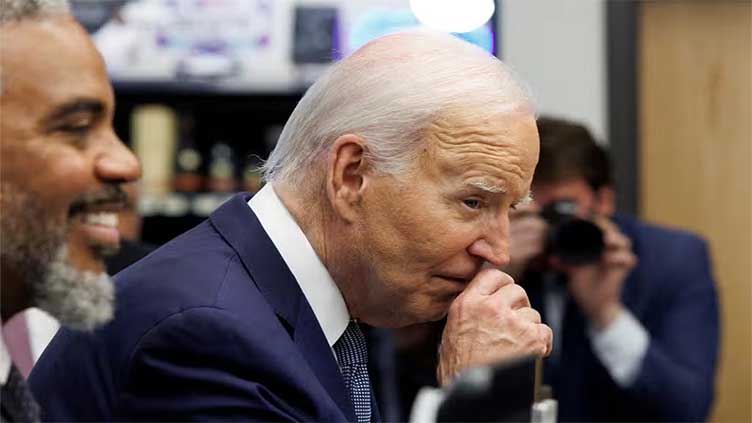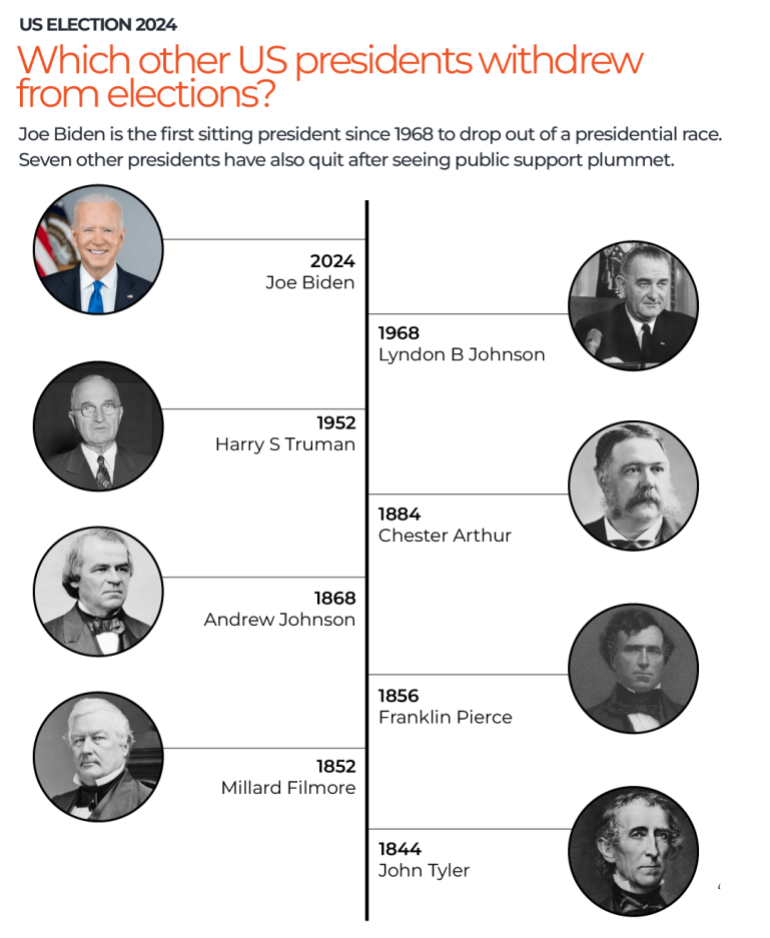How many US presidents pulled out of election?

World
Biden is the first sitting president since 1968 to drop out of a presidential race
(Web Desk) - Failing health and low approval rating forced United States President Joe Biden to finally surrender to pressure and withdraw from the November presidential election.
His withdrawal from the race opens up questions about who might replace him on the Democrat ticket less than four months before the ballot. Biden himself endorsed Vice President Kamala Harris for the party’s nomination, but the Democratic National Convention, scheduled for next month, is where Biden’s successor as standard bearer might well be decided.
The pressure started building up on President Biden from within his party following a disastrous performance in the presidential debate on June 27, when he mumbled his answers and appeared to lose his thought at times. In recent days, a flood of Democratic leaders, including members of Congress and influential supporters of the party, have called on him to step aside from the race. The coronavirus proved the last nail in the coffin as on Thursday, it was announced that he was suffering from Covid-19.

Biden is the first sitting president since 1968 to drop out of a presidential race. So, let’s see how rare is this moment in the US history? Let’s look back at previous incumbents who have dropped out – or been forced out – of presidential elections they had hoped to win.
1968 election: Lyndon B Johnson
Before Biden, no incumbent eligible for another term had opted out of the election in nearly half a century.
Back in 1968, Democrat Lyndon B Johnson was the sitting president. He had served as the vice president to President John F Kennedy following the 1960 election and then had taken charge as president after Kennedy’s assassination in November 1963. Johnson then won the 1964 election.
At the start of 1968, Johnson was the frontrunner for his party’s nomination, but only narrowly won the New Hampshire primary against anti-Vietnam War challenger Senator Eugene McCarthy.
His approval ratings were in free fall, as popular sentiment against the Vietnam War grew. By March 10, his approval rating had fallen to 36 percent, the lowest it had been in his presidency.
Then, on March 31, about seven months before the election, Johnson announced on national television that he would not be seeking re-election. He was 60 at the time.
Johnson’s VP Hubert Humphrey eventually replaced him on the ticket and Republican challenger Richard Nixon won the election.
1952 election: Harry S Truman
Like Johnson would some years later, Truman came to the top job via the vice presidency. He was VP to Franklin Roosevelt until the latter’s death in early 1945, when Truman took charge. He served the remainder of that term, won the election in 1948, and was eligible to run for his second full term in the 1952 election.
Indeed, Truman started the primary season as the incumbent seeking re-election. But by February 9, 1952, his approval rating had cratered to 22 percent, an all-time low.
On March 29, 1952, Truman announced that he would not be running again. Initially reluctant, Illinois Governor Adlai Stevenson ran in place of Truman and lost to Republican Dwight Eisenhower.
1884 election: Chester Arthur
Arthur was the running mate of Republican James Garfield, who won the presidency in 1880. Garfield was assassinated in 1881 and Arthur assumed office in his place. While he was president, Arthur contracted a kidney disease, which remained unknown to the public.
He lost the support of his strongest allies by going against the patronage system, signing a law that banned kickbacks in the civil services and made merit the criteria for determining salaries and promotions.
During the Republican nomination convention in June 1884, when he was seeking re-election, Arthur lost his nomination to James Blaine.
In the November 4 election, Democrat Grover Cleveland defeated Blaine.
1868 election: Andrew Johnson
Democrat Johnson was the running mate of Abraham Lincoln on the National Union Party ticket in 1865.
The same year, Lincoln was assassinated and Johnson took his place.
He was impeached in May 1868 and convicted by a Republican Congress. He was convicted of violating the Tenure of Office Act after he removed Republican Secretary of War Edwin Stanton.
Johnson failed to be nominated by the Democrats, who nominated Horatio Seymour. In the election, Republican Ulysses Grant defeated Seymour.
1856 election: Franklin Pierce
Sitting Democratic President Pierce was the first full-term president of the US to not be nominated by his party for a second term. This decision came on June 2, 1856, five months before the November 4 election.
Pierce had bled support among northern Democrats since the passage of the Kansas-Nebraska Act of 1854, which allowed the two new states to decide on the legality of slavery in their territories. This upset anti-slavery northern Democrats.
At the Democratic National Convention, those tensions came to a head. The party dumped Pierce’s candidature and instead chose James Buchanan as their nominee. Buchanan won the election.
1852 election: Millard Fillmore
Fillmore was the vice president of conservative Whig Party President Zachary Taylor, who died in 1850, a little more than a year after assuming office.
The Whig Party convention in June 1852 did not choose Fillmore and instead went with Winfield Scott to run in the November 2 election. This followed a split between the supporters of Fillmore and Secretary of State Daniel Webster.
Scott lost the election to Democrat Franklin Pierce.
1844 election: John Tyler
Tyler was the running mate of Whig President William Henry Harrison, who took office after winning the 1840 election.
Harrison died of an acute illness in 1841. Following this, Tyler was sworn in as president – the first time a VP was taking over as president mid-term after the death of an incumbent.
During his presidency, Tyler lost support within his party and was expelled by the Whigs in 1842. In 1844, he nonetheless sought re-election after his drive for the annexation of Texas – which would have expanded the territorial ambit of slavery while risking war with Mexico – divided the nation.
However, the Democratic Party picked James Polk. The Whig party, meanwhile, denied Tyler its nomination at the party’s national convention, picking Henry Clay instead. On August 20, 1844, Tyler dropped out of the race.
Polk won the election against Clay. – Courtesy Al Jazeera



